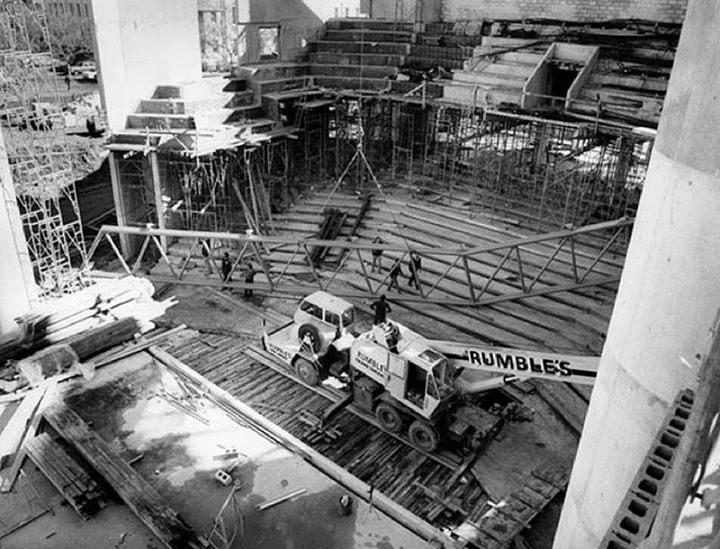Named after the School of Music's founding Director, Ernest Llewellyn, Llewellyn Hall is Canberra's premier concert hall and is one of the finest acoustic venues in Australia. It has a seating capacity of 1335; 960 in the stalls and 375 in the gallery. The School of Music building is listed on the Commonwealth Heritage List.
Llewellyn Hall is home to many local and international acts, with regular performances from the Canberra Symphony Orchestra, Australian Chamber Orchestra and Musica Viva. Famous for being Canberra’s premier concert hall, Llewellyn has also proven a brilliant venue for a variety of performances, including contemporary music, comedy, dance and public lectures. With a brand new L-Acoustics audio system, Llewellyn Hall is a classical venue with the capabilities of a modern performance space.
Venue management
Llewellyn Hall is a part of the Australian National University and is housed in the School of Music Building. Llewellyn Hall and its adjacent venues are managed by the ANU's Venues & Functions team. This team encompasses professionals who are experienced in event management, production coordination, staging, technical services and marketing.
Contact Us
Email: music.venues@anu.edu.au
Postal Address:
Llewellyn Hall ANU
Level 4
School of Music Building #100
William Herbert Place
Australian National University
ACTON ACT 2601
Lost property
If you have left your belongings behind after a show, please email music.venues@anu.edu.au detailing:
- Your name, phone number and email address.
- Item description.
- Date and performance, you attended.
- Where you believe you lost the item.
- Where you were seated (if applicable)
Ticketing and other enquiries
If you have a ticketing enquiry please contact Ticketek on 1300 665 915 or contact the performing arts organisation directly.
TICKET RESALE AND SCALPING
The practice of buying and selling tickets for profit has always existed but, in the digital era, the scale of Scalping has increased substantially. The management cannot guarantee the authenticity of tickets bought on the secondary market and reserves the right not to honor tickets purchased via unauthorised re-sellers such as: viagogo, ticketmaster resale, gumtree, ebay, ticketbits, queenoftickets among others.
ACO
- Box office: 1800 444 444
- boxoffice@aco.com.au
- General enquiries: +61 2 8274 3800
- aco@aco.com.au
Canberra Symphony Orchestra
- Box office: (02) 6262 6772
- tickets@cso.org.au
- General enquiries: (02) 6247 9191
Musica Viva Australia
- Box office: 1800 688 482
- General enquiries: +61 2 8394 6666
- contact@musicaviva.com.au
- Canberra Office: Tel: +61 2 6251 9368
Venue hire
If you are interested in hiring a venue please email music.venues@anu.edu.au. See the venue hire page for more details.
Connect with us:
History
Opened in September 1976, by the then Governor General Sir John Kerr, the School of Music building is a grand architectural statement in the “Brutalist” style. The building was designed for the National Capital Development Commission in 1970 by architects Daryl Jackson and Evan Walker from the firm Jackson Walker; Daryl Jackson would go on to build an international reputation and company, with offices in several Australian capital cities and also in London. The site had been the oval for the old Canberra High School and was chosen for its ability to link the Australian National University campus with the Canberra city centre.

Llewellyn Hall
Internationally distinguished Australian violinist Ernest Llewellyn had been director of Canberra’s School of Music since 1965 when the school had been established and housed in temporary accommodation at Manuka. In the early 1970’s when Ernest Llewellyn was given the approval to proceed with his plans for a new centre of musical learning in Canberra, he envisioned a school of music that would not only be a centre of creativity and performance but also be the home of a world-class concert venue. Ernest Llewellyn had insisted from the outset that the building should be located on a site that was both central to the Australian National University and the city centre, easily accessible for both students and patrons.
Llewellyn Hall underwent a $10 million transformation during 2008 which included honey coloured wood panelling, warm floor boards and a graceful curve of red seating. The hall’s appearance is magnificent but at the core of the renovation was the directive to achieve the best acoustics possible. The stalls and stage area was completely remodelled to achieve this goal. Much greater intimacy has been achieved between musician and patron by moving the stalls seating closer to the stage and the seating rake has been optimised for sound and sightlines. Altogether, 1800 square metres of Ironbark flooring were used, together with 5 cubic metres of Spotted Gum for stair nosing’s and trims. In addition, nearly 15 cubic metres of European Beech needed to be profiled for the acoustic fins on the walls.
The School of Music building is listed on the Commonwealth Heritage List (CHL)
Sustainability
Llewellyn Hall at ANU is a leader in sustainability, committed to minimizing environmental impact and fostering a greener future. With initiatives like reducing energy consumption through LED lighting, aiming for net zero emissions by 2025, and embracing circular economy principles, Llewellyn Hall is at the forefront of sustainable practices. Additionally, a significant annual donation of $5,000 to Greening Australia underlines our dedication to conservation and biodiversity. These efforts showcase Llewellyn Hall's commitment to environmental stewardship, aligning with our vision for a sustainable community and planet. Join us in celebrating and supporting our green journey.
For an in-depth exploration of our environmental initiatives and how we're paving the way for sustainability at Llewellyn Hall, please visit our comprehensive Llewellyn Hall Sustainability Plan. Discover how we're contributing to a sustainable future through our actions and commitments.

